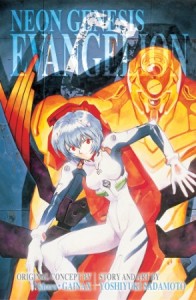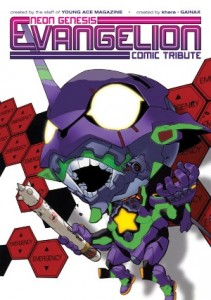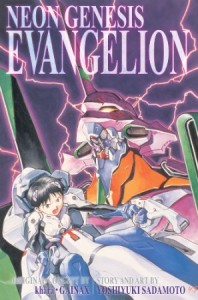By Yoshiyuki Sadamoto and GAINAX. Released in Japan by Kadokawa Shoten, serialized in the magazine Shonen Ace. Released in North America by Viz Media.
These volumes of Evangelion were coming out just as the TV series was finishing, so by now readers had a general idea where things were going to go. And so that allows Sadamoto to start to mix things up and change what we expect to see. There’s no radical alterations here, but some introductions are different, and one character’s fate is changed – for the worse.
Rei features on the cover, but really has very little to do in these three volumes. That said, her one major scene is quite good. Shinji is still angsting about his father, and how he hates him but knows he’d like that to change. Rei points out that being silent isn’t changing anything, and he should talk to his father. So he does! And he gets shut down cold, as it becomes clear that Gendo is never going to bond with Shinji in any parental way, or stop using him as a tool. (Ironically, telling Shinji to stop trying to get closer to him might be the nicest thing Gendo does for him.) Rei also realizes that for all that Gendo is supposedly closer to her, it’s merely a facade, and I think that bothers her, in her own Rei sort of way.
Of course, the majority of this omnibus is focused on the arrival of Asuka. As noted above, she gets a different and far cooler introduction to the story, taking out an Angel by herself and then beating up a group of street punks to save Shinji’s butt. That said, she’s as harsh and abrasive as ever – except around Kaji, of course. (Kaji shutting Asuka down towards the end of this volume is handled quite well – he clearly knows what is going on and has been ignoring the hell out of it, but Asuka stripping in front of him lets him know he can’t do that anymore. Actually, Kaji in general is handled really well in the manga.) Shinji’s scenes with Asuka are usually the funniest parts of the books, and they also get some sweet bonding moments, showing them starting to open up to each other a little bit.
Then there’s the last third of this omnibus. I wonder if Sadamoto had heard people talking about how the manga was a lighter, more optimistic take on the anime and said “Oh yeah? Well take this!” All of Vol. 6 is devoted to Toji being selected as the 4th pilot, and all that stems from that. And it’s horrible, in the best possible way. In particular, Hikari’s tsundere antics (genuine tsundere, as opposed to Asuka’s “I am at heart emotionally broken” tsundere) are simply impossible to read as anything but tragic, and the last scene of the volume is a perfect “OK, gonna go sob in the corner now” capper. I hated reading it, but it was handled in a fantastic way.
So with that cliffhanger, we’ve been shown that the happy fun times of Evangelion are over. How Shinji reacts to his role in all this – as well as what his father did – will no doubt take up part of the next book. In the meantime, if you never read this series, this oversize omnibus with color pages and detailed notes explaining the confusing backstory is a perfect introduction.



